In the era of digitalization, businesses worldwide are continuously seeking innovative ways to automate manual processes and engage customers to improve their online shopping experience. A significant breakthrough in this pursuit is the use of advanced AI models, particularly ChatGPT, for powering intelligent chatbots. In this article, we’ll delve deep into understanding how to use GPT chat, a tool with immense potential that can revolutionize your e-commerce operations and give your business a distinct competitive advantage.
Contents:
2. Benefits of ChatGPT for e-commerce
3. What e-commerce business tasks will ChatGPT do worse than a real person?
4. ChatGPT in use: Creation of e-commerce store with AI capabilities
- Task #1. Naming the store and creating a description
- Task #2. Creating a privacy and refund policy
- Task #3. Marketing strategy
- Task #4. Content strategy
- The final result of ChatGPT
Understanding ChatGPT
At its core, ChatGPT, developed by OpenAI, is a sophisticated language-processing AI. It’s capable of understanding and generating text that’s remarkably close to human conversation, thereby making it an ideal choice for customer-centric aperating text that’s remarkably close to human conversation, thereby making it an ideal choice for customer-centric applications such as AI chatbots. Compared to GPT-3, GPT-4 presents a substaplications such as AI chatbots. Compared to GPT-3, GPT-4 presents a substantial leap in terms of understanding and responding to nuanced dialogues, which translates into a superior user experience in customer service and sales applications.
Benefits of ChatGPT for e-commerce
When you leverage ChatGPT in your e-commerce strategy, you unlock several powerful benefits:
Customer service enhancement
Customer service is a critical component of any successful e-commerce business. With online shopping, customers expect quick and effective responses to their queries. GPT chatbots are designed to provide 24/7 customer service. This means that whether a customer has a query in the middle of the day or the middle of the night, GPT chatbot is there to provide immediate assistance.
Moreover, GPT chatbots can handle multiple customer interactions simultaneously, a feat unattainable for human customer service representatives. This capacity to manage many customer queries at once can drastically reduce customer waiting times, leading to improved customer satisfaction.
One of the most transformative benefits of using GPT chatbots in customer service is the ability to free up human customer service representatives to deal with more complex queries. While GPT chatbots are excellent at handling straightforward, common inquiries, there will always be more nuanced or complex situations that require the human touch. By allowing GPT chatbots to deal with more routine queries, human representatives can focus their time and energy on situations that require more in-depth attention.
Personalized recommendations
In the vast and often overwhelming world of e-commerce, offering personalized suggestions with the help of GPT can significantly improve the customer’s shopping experience and increase the likelihood of them making a purchase.
In this process, GPT chatbots excel. They can analyze large amounts of data from a customer’s past interactions, including their browsing history, past purchases, clicked links, and even abandoned carts. Using this information, GPT chatbot can draw insightful conclusions about the customer’s preferences and potential needs.
For example, if a customer frequently buys nutritional supplements and has been browsing the sports equipment section, GPT chatbot might suggest relevant products like protein shakers or workout gear. This level of personalization can make the shopping experience more relevant and enjoyable for the customer, and at the same time, it increases the likelihood of further purchases.
Furthermore, these GPT chatbots can learn and adapt over time. As the customer continues to interact with the e-commerce platform, GPT chatbot gets more data and continues to refine its understanding of the customer’s preferences, making its recommendations even more accurate and relevant.
Sales and marketing
GPT chatbots can play a pivotal role in lead generation. By initiating conversations with potential customers who visit your website, GPT chatbot can engage visitors, gather contact information, and answer initial questions or concerns. This immediate interaction can make the difference between a visitor merely browsing your site and becoming a potential lead.
Moreover, GPT chatbots can handle the early stages of the sales funnel, where routine questions and initial interactions occur. By doing this, chatbot software free up your sales team to focus on the later stages of the funnel, where human interaction can make a substantial difference.
GPT chatbots can also guide customers through the buyer’s journey. They can provide detailed product information, compare different products, provide personalized recommendations, and even help with the checkout process. This kind of guidance can help reduce shopping cart abandonment and improve conversion rates.
In terms of marketing, GPT chatbots can inform customers about new products, special offers, and discounts based on their preferences and past purchases. These personalized messages might add much more value to general marketing campaigns.
Further, GPT chatbots can help with customer segmentation. By analyzing customer behavior and preferences, GPT chatbots can help categorize your customers into different segments. This segmentation allows for more targeted and personalized marketing campaigns.
Analytics, insights, and business intelligence
Beyond customer service and operational roles, GPT can offer support to e-commerce businesses by analyzing customer data to extract insights, akin to having an accountant for ecommerce business. It can be trained to identify patterns and trends in customer behavior and transaction data, providing business owners with actionable intelligence.
These insights can be integral in refining marketing strategies, optimizing product mix, and improving overall business decision-making. Understanding customer behavior can help predict future trends and adapt strategies accordingly, thereby staying a step ahead in the market.
Furthermore, these data-driven insights can also be leveraged for risk assessment, fraud detection, and enhancing the overall security of the e-commerce platform.
Automating operational processes
Another critical area where GPT can be instrumental is in automating various operational tasks, similar to the efficiency brought by DHL Ecommerce in logistics. E-commerce businesses involve numerous repetitive tasks that can consume significant resources and time. GPT can assist with tracking orders, providing regular updates on shipping status, managing returns and exchanges, and answering frequently asked questions. By automating these tasks, businesses can free up their human resources, allowing staff to focus on more strategic and creative aspects of the business.
This not only improves operational efficiency but can also lead to cost savings in the long run.
What e-commerce business tasks will ChatGPT do worse than a real person?
As powerful and versatile as AI and ChatGPT can be, they aren’t yet capable of completely replacing human involvement in all aspects of e-commerce. There are certain tasks and roles where humans still outperform AI.
Handling complex customer service scenarios
While GPT chatbots have significantly improved in understanding and responding to customer queries, they can sometimes struggle with highly complex or unique situations that deviate from their training data. A human agent, on the other hand, can think critically, apply common sense, and draw from personal experience to handle these scenarios more effectively.
Emotional intelligence
Humans possess emotional intelligence, enabling them to understand subtle nuances in language, tone, and context. This allows them to empathize with customers, which is particularly crucial during sensitive or emotionally-charged interactions. ChatGPT, despite its advances, lacks this emotional acumen and can sometimes misinterpret or completely miss these nuances, resulting in an unsatisfactory customer experience.
Negotiation in chat
Humans excel in negotiation situations, where understanding cultural nuances, emotions, and non-verbal cues can make a significant difference. ChatGPT is yet to master these intricate human interactions.
Creative work
While ChatGPT can generate creative content to a certain extent, it still falls short when compared to a human’s ability to create original, innovative ideas. From designing unique marketing campaigns to creating captivating visual content, the human touch often makes a significant difference.
Decision-making in ambiguity
ChatGPT performs well in well-defined, structured situations. However, when it comes to making decisions in ambiguous or unpredictable situations, humans still outshine AI. Humans can make judgments based on intuition, consider ethical implications, and adapt to changing circumstances dynamically.
Understanding and adapting to cultural context
Businesses that operate globally need to understand and adapt to the cultural nuances of different regions. While ChatGPT can be trained to understand different languages and certain cultural aspects, it isn’t yet capable of fully grasping the depth of cultural diversity and subtlety in the same way a human can.
Establishing genuine human connections in chat
Despite the impressive capabilities of ChatGPT, it can’t replicate the genuine human connection that customers often seek from brands. Personal stories, shared experiences, and real human engagement are essential aspects of building strong brand-customer relationships, and these are areas where humans decidedly outperform AI.
While ChatGPT continues to progress at a rapid pace, these areas illustrate the continued importance of human involvement in e-commerce businesses. A balanced approach that leverages the strengths of both AI and human intelligence is likely to yield the most successful outcomes.
ChatGPT in use: Creation of e-commerce store with AI capabilities
After looking through the main strengths and weaknesses of ChatGPT and AI in general, let’s see how to use ChatGPT. We’ll try to come up with our own tasks for ChatGPT and create a potential store by analyzing the AI answers generated based on the requests. The main point is to test AI capabilities and see how to use ChatGPT to cover e-commerce business needs.
Task #1. Naming the store and creating a description
The first step will be giving ChatGPT the information about what you want to sell and creating a description for the potential customers. Let’s start with the name.
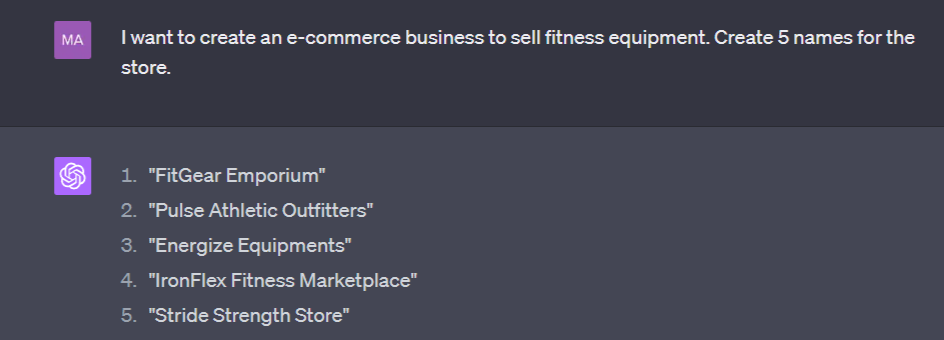
The options are good, but they are too pretentious for an e-commerce store. We need something catchy so the customers will remember it. Let’s ask ChatGPT to spice them up a bit.

These are definitely better! Let’s take the first one, SweatShoppe, since it represents the main goal of the products sold in the store and is easy to remember. The name might look a bit silly, though it’ll be on the customers’ minds because of the catchiness.
The next step is to create a description for the store with the help of ChatGPT. Let’s see.
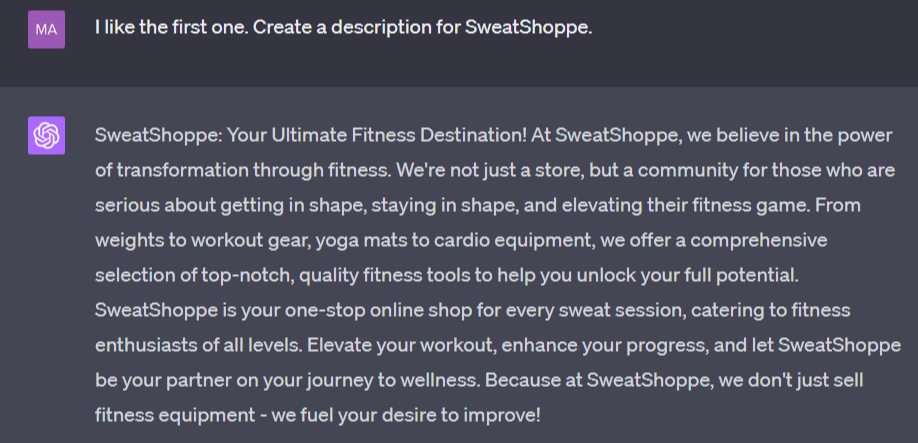
Pretty motivational yet straight to the point. However, there are a lot of vague sentences addressing everyone and no one at the same time. Let’s try to use our potential target audience and regenerate the description based on this information.
After giving the basic description of the target audience (age range and gender), ChatGPT generated the description mentioning all the given statistics.
The first request:
Our target audience:
Age range – 25-40 years old
Gender – both male and female
Recreate the description based on this information
The second request:
Don’t mention the age range
ChatGPT response:
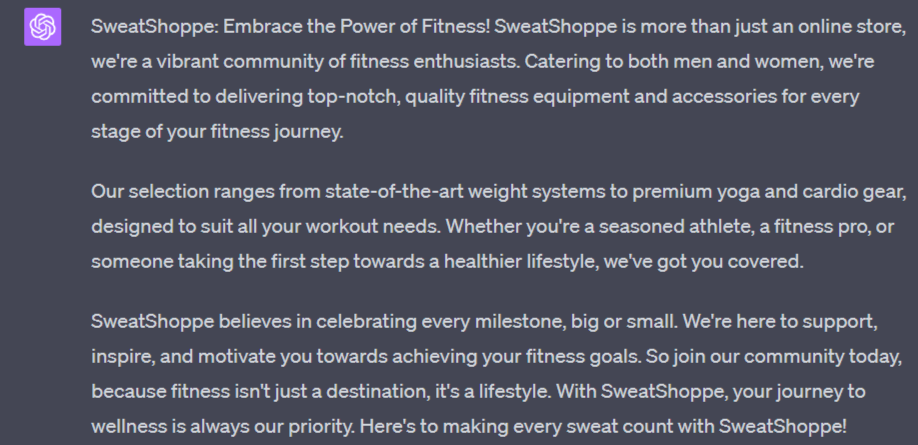
Task #2. Creating a privacy and refund policy
Next, we’ll try to create two policies: privacy and refund. Even though there were hundreds of thousands of possibilities of how ChatGPT could have replied, the generated results were quite decent.
GPT prompt:
Create a privacy policy for the store
ChatGPT response:
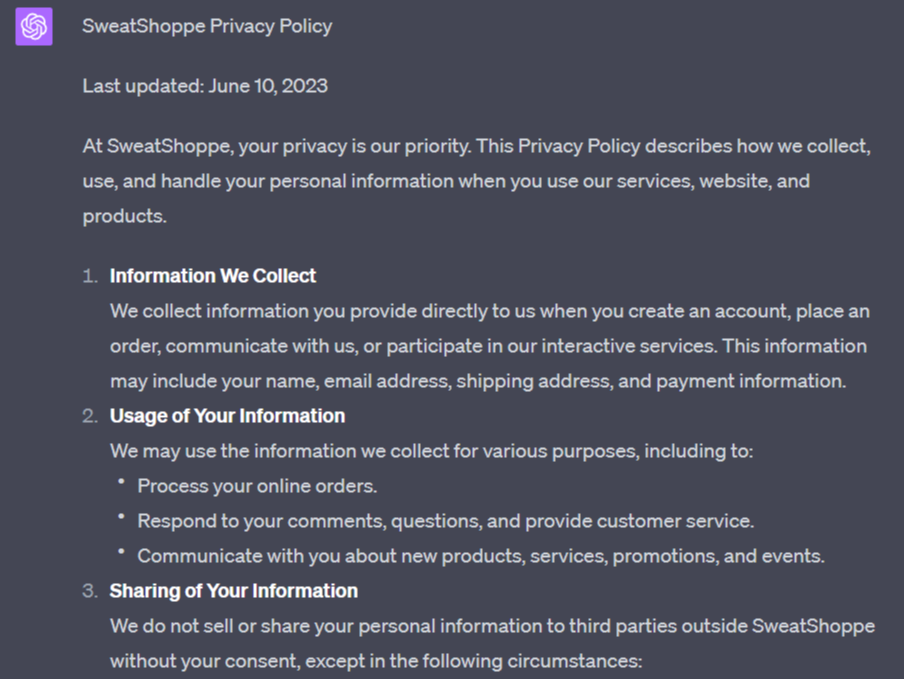
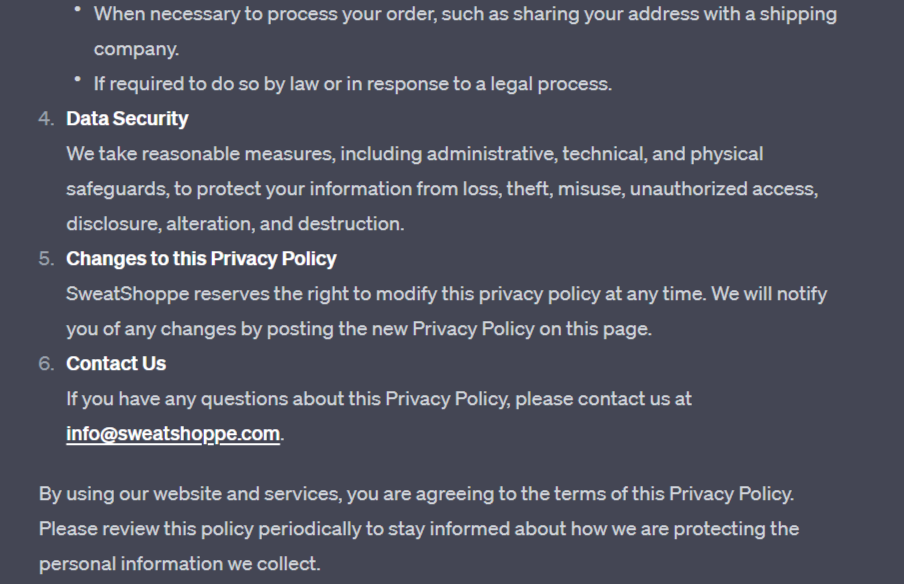
GPT prompt:
Create a refund policy
ChatGPT response:
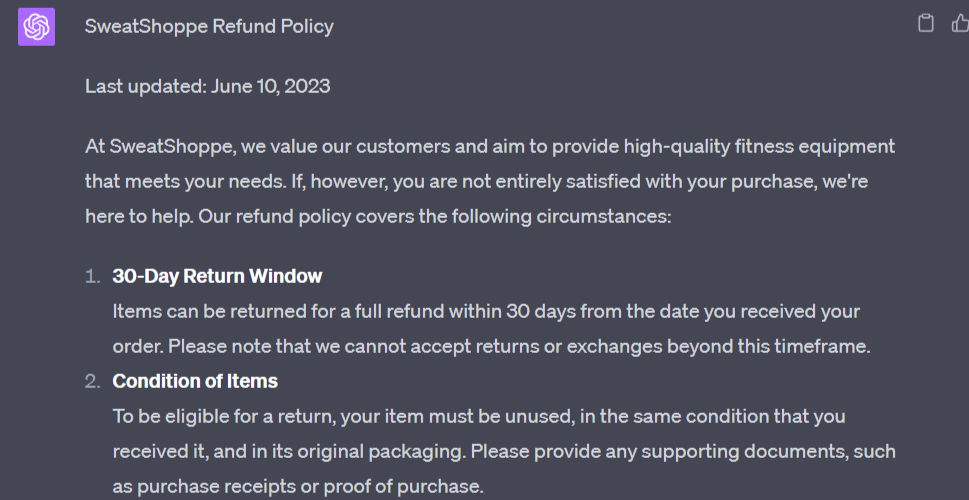
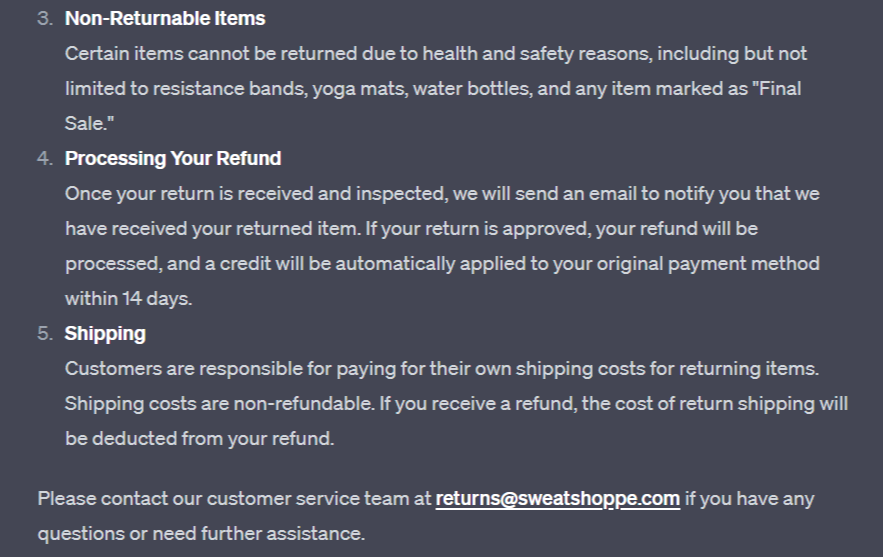
Task #3. Marketing strategy
At this step, we’ll ask ChatGPT to generate a marketing plan for SweatShoppe. The strategy will not only focus on traditional marketing but also integrate modern ecommerce solutions like Ecommerce as a Service to streamline operations and enhance customer experience.
GPT prompt:
Write a custom step-by-step marketing strategy SweatShoppe can implement, considering the integration of modern ecommerce solutions.
ChatGPT response:
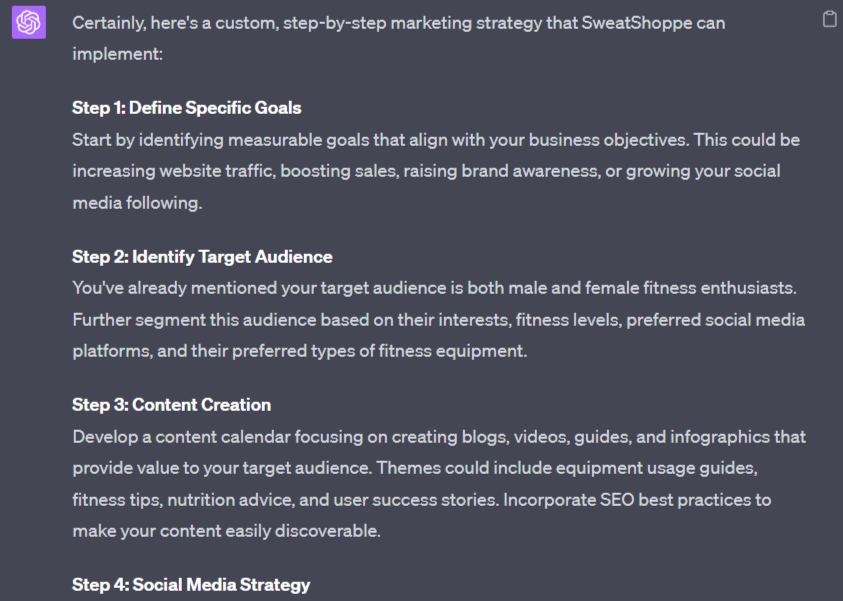
There were also such steps as
- Working out influencer partnerships
- Paid advertising
- Industry events and conferences
- Creating a referral program
- Customer engagement
- Reviewing and refining the strategy
Note: In Step 2: Identify Target Audience, even though some information about the target audience was already mentioned before, ChatGPT suggested going into more detail.
If you decide to follow the strategy ChatGPT provides you with, you can simply ask for a better explanation of a step you have the most trouble with. Just write “Expand step [NAME OF THE STEP]” or “Give me a step-by-step process for the step [NAME OF THE STEP]”. For example, you want to learn more details about implementing paid advertising:
GPT prompt:
Give me a step-by-step detailed process of how to implement a paid advertising strategy.
ChatGPT response:
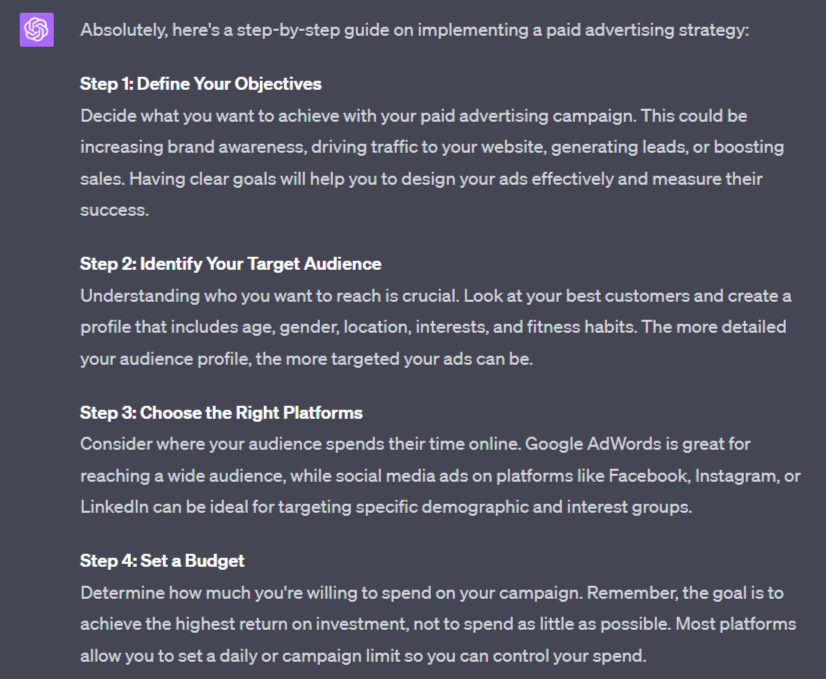
There were also such steps as
- Design your ads
- Optimize for SEO
- Launch your campaign
- Monitor your ads
- Test and refine
- Scale successful campaigns
Taking into account everything mentioned above, you can ask for explanations and details as much as you want, deploying each step of a marketing strategy into a more detailed plan. It’s definitely not the best decision to fully rely on what ChatGPT tells you to do with your business, especially when you’ve been selling online for some time, but you can surely try playing with different prompts, using an AI prompt library, for inspiration for anything you can do yourself or you’ve never done before
Chat GPT is also a worthy solution for newbies that are just trying to get into the world of e-commerce and may be lost in the pool of options to choose from. At an early stage, it can help with creating a plan so you’ll have everything in order.
Task #4. Content strategy
When providing general information about your business specifics, you can ask ChatGPT to generate a content strategy which you can use. It might be just some ideas or a comprehensive content plan for a month.
In the first case, you can simply ask to generate ideas for your blog, guide, or social media post.
GPT prompt:
Create 5 relevant ideas for the blog articles.
ChatGPT response:
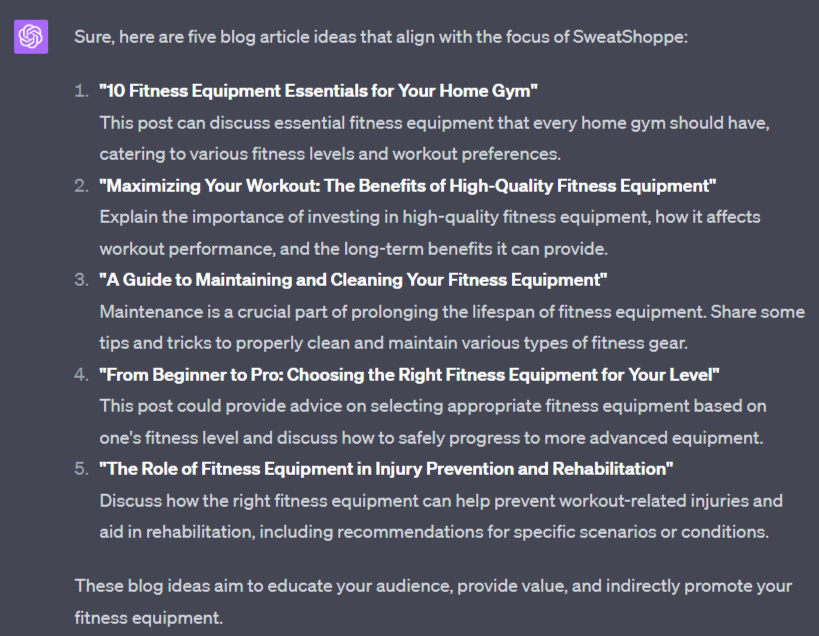
As you can see, ChatGPT not only provided potential titles for the articles but also gave an outline of the main points.
Let’s try another scenario with an Instagram post.
GPT prompt:
Create an Instagram post introducing a new product – a yoga mat.
ChatGPT response:

Another way of using ChatGPT for content planning is asking AI to generate a full content calendar with unique blog ideas. Here’s a prompt you could try.
GPT prompt:
Create a table with a content strategy for 30 days using 30 most popular and related keywords. Each day we should have 1 piece.
ChatGPT response:
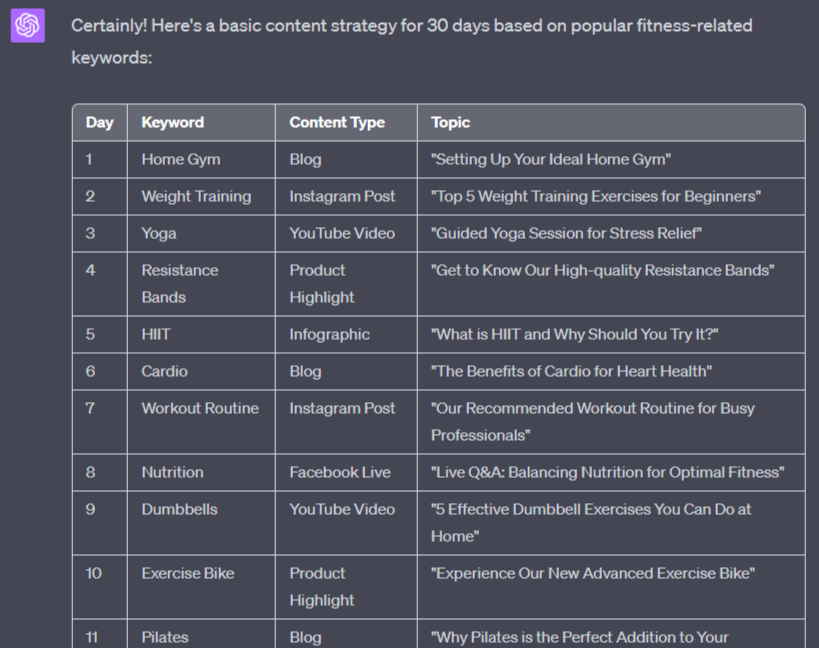
The table has all the related topics and can be used as a starting point for a real content strategy. You can also specify the amount of pieces you want to provide on each particular platform and ask ChatGPT to recreate the table based on this information.
Even if you don’t like the provided content plan, you could make use of the keywords and topics recommended by ChatGPT and come up with your own plan employing the given target keywords and potential ideas for the content pieces.
The final result of ChatGPT
We’ve started from scratch and created a potential e-commerce store for fitness equipment with its own policies, marketing strategy and content plan. It’s true that the results aren’t as detailed as they might be if made by a real person. However, it can be a perfect starting point when you want to have at least something to fall back on before taking action.
Let’s now look at the result of our work and the way ChatGPT can introduce our SweatShoppe store to the audience.
GPT prompt:
Introduce SweatShoppe.
ChatGPT response:
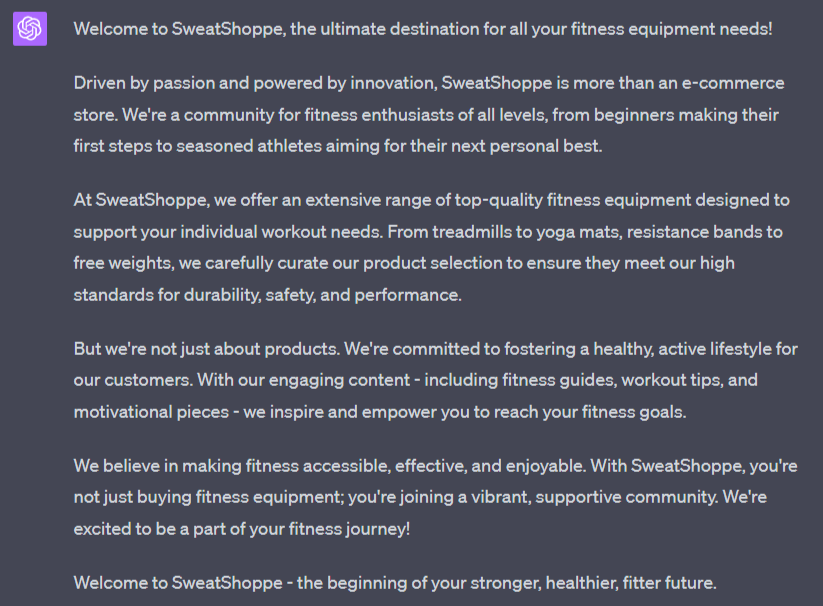
Conclusion: Is it worth implementing ChatGPT into the e-commerce business strategy?
Incorporating ChatGPT into your e-commerce business can drastically transform your operations, offering enhanced customer service, improved sales tactics, and efficient marketing strategies. As AI technology continues to advance, the key to staying competitive in the rapidly evolving digital market is learning how to use these tools effectively and identify the most important points. Adapting and evolving with technology is no longer an option but a necessity for businesses looking to succeed in today’s e-commerce landscape.
However, it’s important to double check the results provided by ChatGPT, especially for a blog post, a policy or an email flow for your customers. Remember that detailed AI texts require detailed instructions, as ChatGPT is just an aide, but never a 100% solution.







.png)

This article on utilizing ChatGPT for e-commerce success offers valuable insights into how AI technology can revolutionize the way businesses operate online. It’s fascinating to see how AI can assist in improving customer experiences and streamlining processes.
I’m very glad you found it so valuable. ChatGPT is really changing the way businesses operate.
Amazing Post. ChatGPT is a boon for all enterprises they have just made things simpler.